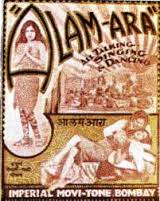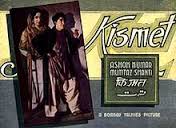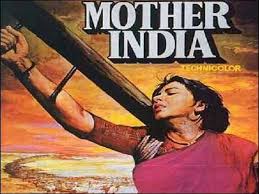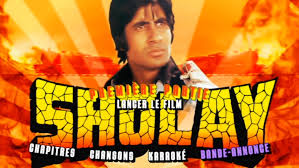 The history of film began in the late 1880s with the invention of the first movie camera. Motion pictures were initially exhibited as a carnival novelty and developed to one of the most important tools of communication and entertainment, and mass media in the 20th century and into the 21st century. Most films before 1930 were silent. Motion picture films have substantially affected the arts, technology, and politics.
The history of film began in the late 1880s with the invention of the first movie camera. Motion pictures were initially exhibited as a carnival novelty and developed to one of the most important tools of communication and entertainment, and mass media in the 20th century and into the 21st century. Most films before 1930 were silent. Motion picture films have substantially affected the arts, technology, and politics.
Films arrived in India less than a year after the Lumieres first exhibited their cinematographie in Paris. On July 7, 1896, an agent who had brought equipment and films from France first showed his moving pictures in Bombay. That was an important day in the social and cultural history of the Indian people.
The first Indian-made feature film (3700 feet long) was released in 1913. It was made by Dadasaheb Phalke (Father of Indian Cinema) and was called Raja Harishchandra. Based on a story from the Mahabharata it was a stirring film concerned with honour, sacrifice and mighty deeds. From then on many “mythologicals” were made and took India by storm. Phalke’s company alone produced about a hundred films.
The Modern Era (1930-1945)
 The silent era came to an end when Ardeshir Irani produced his first talkie, ‘Alam Ara’ in 1931. If Phalke was the father of Indian cinema, Irani was the father of the talkie. The talkies changed the face of Indian cinema. Apart from looks, the actors not only needed a commanding voice but also singing skills, as music became a defining element in Indian cinema.
The silent era came to an end when Ardeshir Irani produced his first talkie, ‘Alam Ara’ in 1931. If Phalke was the father of Indian cinema, Irani was the father of the talkie. The talkies changed the face of Indian cinema. Apart from looks, the actors not only needed a commanding voice but also singing skills, as music became a defining element in Indian cinema.
The year also marked the beginning of the Talkie era in South Indian films. The first talkie films in Bengali (Jumai Shasthi), Telugu (Bhakta Prahlad) and Tamil (Kalidass) were released in the same year. Gradually the rest of India joined in the bollywood race and films started to be produced with political and social themes of the era.
 The forties was a tumultuous decade; the first half was ravaged by war and the second saw drastic political changes all over the world. In the middle of the Second World War in 1945 came ‘Kismet‘ starring Ashok Kumar which became one of the biggest hits in the history of Indian cinema. It had some bold themes – the first anti-hero and an unmarried pregnancy. This film was for two years at the box office. It clearly showed that the filmmakers of the era were bolder than the times in which they were living in. A close relationship between epic consciousness and the art of cinema was established. It was against this backdrop that filmmakers like V.Shantaram, Bimal Roy, Raj Kapoor and Mehboob Khan made their films.
The forties was a tumultuous decade; the first half was ravaged by war and the second saw drastic political changes all over the world. In the middle of the Second World War in 1945 came ‘Kismet‘ starring Ashok Kumar which became one of the biggest hits in the history of Indian cinema. It had some bold themes – the first anti-hero and an unmarried pregnancy. This film was for two years at the box office. It clearly showed that the filmmakers of the era were bolder than the times in which they were living in. A close relationship between epic consciousness and the art of cinema was established. It was against this backdrop that filmmakers like V.Shantaram, Bimal Roy, Raj Kapoor and Mehboob Khan made their films.
In the meantime, the film industry had made rapid strides in the South, where Tamil, Telugu and Kannada films were taking South India by storm. By the late 1940s, films were being made in various Indian languages with religion being the dominant theme.
1940s to late 1950s was also the golden era of music. Shankar Jaikishan, O.P. Nayyar, Madan Mohan, C. Ramchandra, Salil Chaudhury, Naushad, S.D. Burman – all had their distinctive style. Each vied with the other to produce some of the most unforgettable melodies India has ever known.
The Golden Era (1950-1960)
 50s and 60s were considered as the Golden Age of Indian cinema. Filmmakers like Satyajit Ray, Ritwik Ghatak, Guru Dutt, Bimal Roy, Mehboob Khan, K Asif, Raj Kapoor, KV Reddy, L V Prasad and Ramu Kariat made waves in their respective film industries and they went on to make classics like Pather Panchali, Madhumati, Do Bheega Zameen, Shree 420, Awaara, Pyasa, Mother India, Mughal E Azam, Mayabazar and Chemmeen among many other films. In the south, N.T. Rama Rao, M. G. Ramachandran, Sivaji Ganesan, Rajkumar, Prem Nazir dominated the film industry for more than three decades before making way for the next generation of actors like Rajinikanth, Kamal Haasan, Mammootty, Mohanlal, Chiranjeevi and Balakrishna.
50s and 60s were considered as the Golden Age of Indian cinema. Filmmakers like Satyajit Ray, Ritwik Ghatak, Guru Dutt, Bimal Roy, Mehboob Khan, K Asif, Raj Kapoor, KV Reddy, L V Prasad and Ramu Kariat made waves in their respective film industries and they went on to make classics like Pather Panchali, Madhumati, Do Bheega Zameen, Shree 420, Awaara, Pyasa, Mother India, Mughal E Azam, Mayabazar and Chemmeen among many other films. In the south, N.T. Rama Rao, M. G. Ramachandran, Sivaji Ganesan, Rajkumar, Prem Nazir dominated the film industry for more than three decades before making way for the next generation of actors like Rajinikanth, Kamal Haasan, Mammootty, Mohanlal, Chiranjeevi and Balakrishna.
The Masala Films (1970-1980)
 The 70s completely changed the way films were made, especially in Hindi film industry. Changing social norms and changing economies influenced movies and the companies that made them. The narrative style changed. The story structure changed. Characters changed. Content changed. Masala films were the demand of the time. The genre promised instant attraction and had great entertainment value. It was the age of the angry young man and Amitabh Bachchan rose to prominence thanks to the success of Sholay, Zanjeer and Deewar. While Dev Anand, Rajesh Khanna, Jitendra and Dharmendra continued to bask in the glory of back to back hits, the actresses were not far behind. Right from the time of Savitri, Vyjayanthi Mala, Nargis, Waheeda Rahman and Sharmila Tagore to Sridevi, Rekha, Smita Patil, Hema Malini, several actresses became heartthrobs of the nation.
The 70s completely changed the way films were made, especially in Hindi film industry. Changing social norms and changing economies influenced movies and the companies that made them. The narrative style changed. The story structure changed. Characters changed. Content changed. Masala films were the demand of the time. The genre promised instant attraction and had great entertainment value. It was the age of the angry young man and Amitabh Bachchan rose to prominence thanks to the success of Sholay, Zanjeer and Deewar. While Dev Anand, Rajesh Khanna, Jitendra and Dharmendra continued to bask in the glory of back to back hits, the actresses were not far behind. Right from the time of Savitri, Vyjayanthi Mala, Nargis, Waheeda Rahman and Sharmila Tagore to Sridevi, Rekha, Smita Patil, Hema Malini, several actresses became heartthrobs of the nation.
The hodgepodge of action, romance, comedy and of course musical numbers is a model that was developed during this period and still dominates the Bollywood industry, and though greater attention is now paid to plot, character development, and dramatic tension, it is, in most cases, sheer star power that accounts for a film’s success.
The eighties saw the advent of women film makers such as Vijaya Mehta (‘Rao Saheb’), Aparna Sen (’36- Chouwringhee Lane’, ‘Parama’), Sai Pranjpye (‘Chashme Baddoor’, ‘Katha’, ‘Sparsh’), Kalpana Lajimi (‘Ek Pal’), Prema Karanth (‘Phaniamma’) and Meera Nair (‘Salaam Bombay’). It was also the decade when sultry siren Rekha wooed audiences with her stunning performance in ‘Umrao Jaan’ in 1981.
And then in 90’s, it was a mixed genre of romantic, thrillers, action and comedy films. A stark upgrade can be seen on the canvas as technology gifted the industry Dolby digital sound effects, advanced special effects, choreography and international appeal. The development brought about investments from the corporate sector along with finer scripts and performances. It was time to shift focus to aesthetic appeal. And stars like Shah Rukh Khan, Rajnikanth, Madhuri Dixit, Salman Khan, Aamir Khan, Chiranjeevi, Juhi Chawla and Hrithik Roshan began to explore ways to use new techniques to enrich Indian cinema with their performances.
Present Era:
In recent years, Hindi cinema has undergone a massive change due to the emergence of new age filmmakers like Anurag Kashyap, Rajkumar Hirani, Dibakar Banerjee and Vishal Bhardwaj. Of late, Tamil and Marathi cinema has witnessed similar changes with several new filmmakers coming forth to cater to a niche audience.
As the world has become a global village, the Indian film industry has reached out further to international audiences. Apart from regular screenings at major international film festivals, the overseas market contributes a sizeable chunk to Bollywood’s box office collections. Regular foreign Investments made by major global studios such as 20th Century Fox, Sony Pictures, and Warner Bros put a stamp of confirmation that Bollywood has etched itself on the global podium.
Indian cinema, despite all its peculiarities, has been a reflection of the socio-economic, political and cultural changes that took place in the country.















